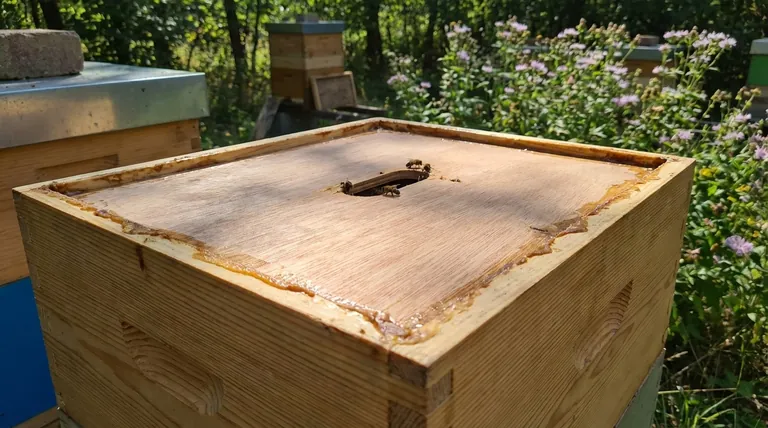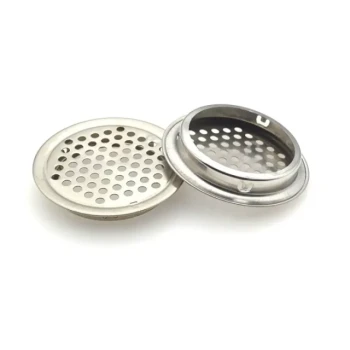At its core, the inner cover is a multi-function tool that makes hive inspections easier, improves the colony's ability to regulate its internal environment, and provides options for feeding and harvesting. It sits between the top box of bees and the main outer, telescoping cover, serving as a crucial barrier and utility piece.
The true advantage of an inner cover is not in any single function, but in how it transforms the top of the hive into a manageable, climate-controlled space. It shifts the dynamic from simply covering the bees to actively managing their environment for better health and productivity.

The Core Functions of a Beehive Inner Cover
An inner cover might seem like a simple wooden board, but each of its features plays a critical role in the health of the colony and the efficiency of the beekeeper.
Preventing a Glued-Shut Hive
Bees use a sticky resin called propolis to seal every crack and seam in their hive, strengthening the structure and keeping out drafts and pests.
Without an inner cover, they would firmly glue the main telescoping cover directly to the top honey super. This makes prying the hive open for inspections difficult and destructive. The inner cover acts as a sacrificial barrier, getting propolized but allowing the outer cover to be removed with ease.
Creating an Insulating Air Gap
The space created between the inner cover and the outer cover forms a pocket of dead air.
This air gap is a surprisingly effective insulator. It helps shield the colony from the direct heat of the sun in summer and reduces heat loss during the cold of winter, allowing the bees to expend less energy on thermoregulation.
Managing Moisture and Ventilation
Proper ventilation is critical, especially during winter. A cluster of bees generates significant warmth and moisture from respiration.
When this warm, moist air hits a cold outer cover, it condenses into water droplets that can drip down on the bees, chilling and potentially killing them. The inner cover helps prevent this direct contact. Many inner covers also have a small notch that provides an upper entrance for ventilation, allowing moist air to escape.
Facilitating Feeding and Harvesting
Most inner covers have a central hole, which is a key utility feature for the beekeeper.
A jar of syrup can be placed directly over this hole for feeding, giving the bees easy access. This same hole is used to place a bee escape, a one-way device that allows you to clear bees out of honey supers before harvesting, making the process much calmer and more efficient.
Understanding the Design and Trade-offs
While the benefits are clear, understanding how to use the inner cover correctly is key to unlocking its full potential.
The 'Summer' and 'Winter' Sides
Many standard inner covers are designed with two distinct sides. One side is flush, while the other has a deeper rim that, when placed down, creates a small gap via the entrance notch.
The notched side is typically used during the active season to provide an upper entrance and extra ventilation. In winter, some beekeepers flip the cover to the flush side to conserve more heat, though ensuring some ventilation remains is still critical.
Is an Inner Cover Always Necessary?
While standard for most Langstroth hives, not all beekeeping setups use a separate inner cover.
Some operations, particularly commercial apiaries that move hives frequently, use migratory lids. These are simpler, single-piece covers that sit directly on the top box. The trade-off is a loss of the insulating air gap and the specific ventilation control that an inner cover provides, exchanged for speed and ease of transport.
Applying This to Your Beekeeping Goals
Your beekeeping priorities will determine which benefit of the inner cover is most valuable to you.
- If your primary focus is simplified hive management: The inner cover is non-negotiable, as it prevents the outer lid from being glued down, making inspections faster and less disruptive.
- If your primary focus is overwintering success: The inner cover's role in creating an insulating air gap and managing moisture is its most critical feature for colony survival.
- If your primary focus is efficient honey harvesting: Its compatibility with a bee escape makes it an essential tool for clearing bees from supers without chemicals or excessive disturbance.
Ultimately, the inner cover is a small component that delivers a significant impact on both colony health and beekeeper efficiency.
Summary Table:
| Advantage | Key Benefit |
|---|---|
| Prevents Glued-Shut Hive | Easy, non-destructive hive inspections |
| Insulating Air Gap | Better temperature control in summer and winter |
| Moisture & Ventilation Management | Reduces condensation, critical for overwintering success |
| Feeding & Harvesting Port | Easy access for feeding and efficient honey super clearing |
Ready to enhance your apiary's efficiency and colony health?
For commercial beekeepers and equipment distributors, the right supplies are the foundation of success. HONESTBEE supplies durable, high-quality beekeeping equipment—including inner covers designed for optimal performance—through our wholesale-focused operations.
Contact HONESTBEE today to discuss your bulk supply needs and get a quote. Let us help you build a more productive and resilient operation.
Visual Guide

Related Products
- Inner Beehive Cover for Beekeeping Bee Hive Inner Cover
- Professional Insulated Winter Hive Wrap for Beekeeping
- Stainless Steel Round Beehive Air Vents for Ventilation
- HONESTBEE Professional Long Handled Hive Tool with Precision Cutting Blade
- Professional Insulated Plastic Bee Hives
People Also Ask
- What is the function of an inner cover in a beehive? Essential for Hive Health & Management
- What is the function of the center hole in the inner cover? Master Hive Ventilation and Feeding
- What is the role of the inner cover in a beehive? Essential Climate Control for Hive Health
- What is an inner cover in a beehive and what are its features? A Key Tool for Hive Health & Management
- Why might beekeepers use an inner cover under the telescoping outer cover? Simplify Hive Management & Protect Your Colony



















